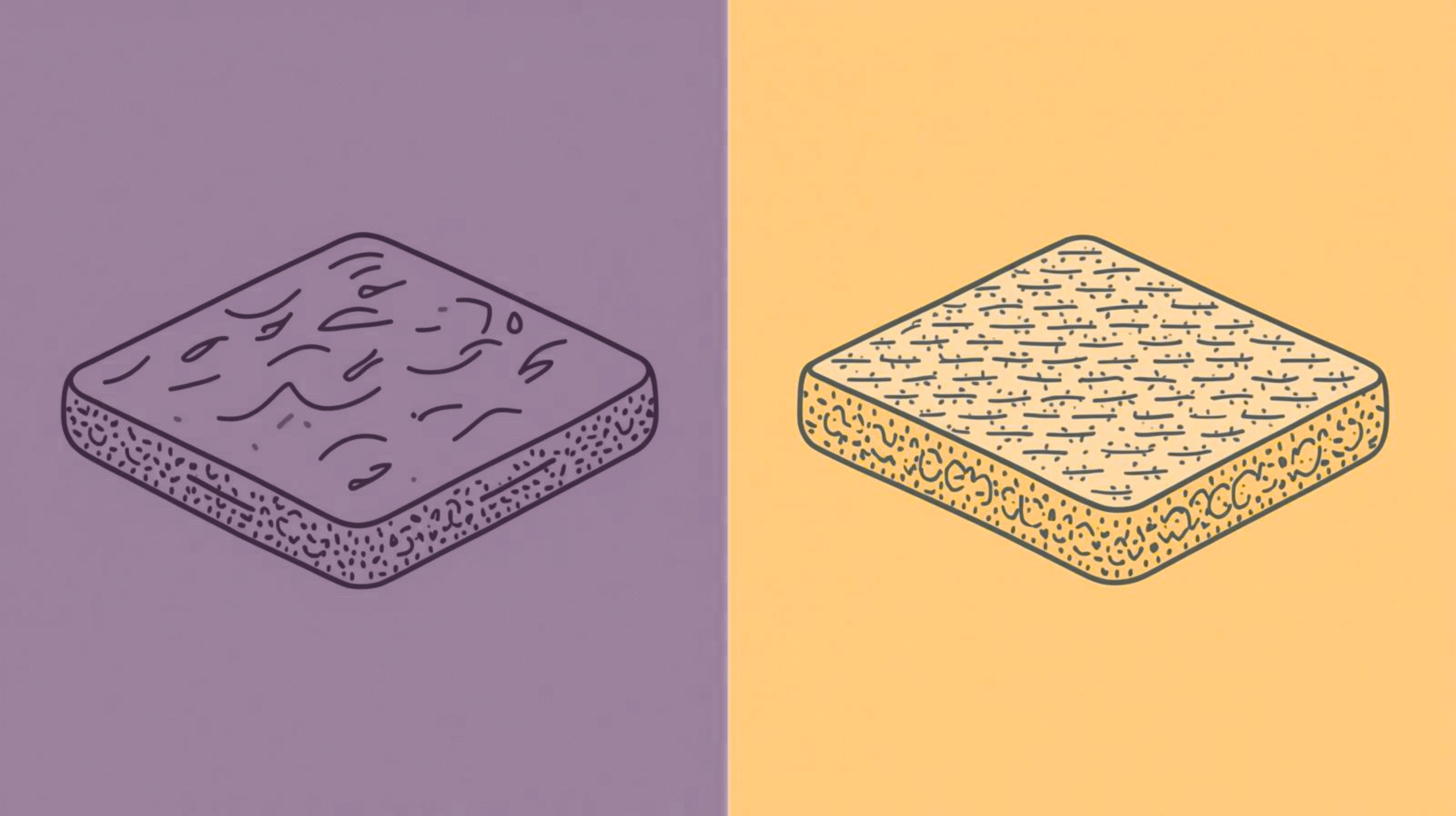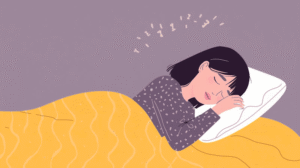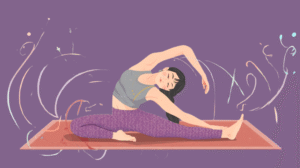Choosing the right mattress is crucial for sleep quality, comfort, and spinal health. Poor sleep or inadequate support can lead to back pain, stiffness, fatigue, and even long-term postural problems. Among the most popular options today are memory foam and gel memory foam mattresses, both renowned for their pressure-relieving properties and comfort.
Memory foam gained popularity for its body-contouring ability, helping sleepers maintain spinal alignment and reduce motion transfer [1]. Gel memory foam, a newer innovation, incorporates gel beads or layers into traditional memory foam to provide enhanced cooling and temperature regulation.
This article explores the differences between memory foam and gel memory foam, comparing their support, comfort, cooling properties, durability, and suitability for different sleepers. By understanding their features and benefits, you can make an informed decision for better sleep, reduced back pain, and long-term health.
What Is Memory Foam?
Memory foam is a high-density polyurethane foam designed to conform to the body’s shape, providing customized support, pressure relief, and spinal alignment. Originally developed by NASA in the 1960s to improve astronauts’ safety during takeoff, it has since become a staple in modern mattresses, pillows, and toppers.
Key Features of Memory Foam
- Pressure Relief
- Memory foam distributes body weight evenly, reducing stress on shoulders, hips, and lower back.
- This makes it ideal for individuals suffering from joint pain, arthritis, or chronic back issues.
- Example: Side sleepers benefit greatly as memory foam cushions pressure points, preventing morning stiffness.
- Body Contouring
- The foam molds to the natural curves of the body, providing custom support for each individual [2].
- Unlike traditional innerspring mattresses, it eliminates gaps between the mattress and body, maintaining consistent contact.
- The foam molds to the natural curves of the body, providing custom support for each individual [2].
- Motion Isolation
- One of memory foam’s most popular features is its ability to absorb movement.
- Ideal for couples, as one partner’s movements won’t disturb the other’s sleep.
- Example: Tossing and turning at night is absorbed by the foam, ensuring uninterrupted rest.
- Durability
- High-density memory foam is long-lasting, retaining shape and support for 7–10 years.
- However, lower-density memory foam may sag over time and require periodic rotation to maintain performance.
Common Drawbacks
- Heat Retention
- Traditional memory foam traps body heat, which may lead to night sweats or discomfort.
- Sleepers in warmer climates or those who naturally run hot may find this problematic.
- Tip: Use breathable mattress protectors or cooling sheets to mitigate heat.
- Initial Firmness Adjustment
- Memory foam can feel firmer initially and may require a few nights to break in.
- Example: Some sleepers report slight discomfort during the first week of use before the foam adapts to body shape.
- Weight Sensitivity
- Heavier individuals may sink deeper, affecting support if foam density is low.
- Choosing high-density memory foam ensures durability and better support for all body types.
Practical Benefits
- Spinal Alignment: Keeps the spine in a neutral position, reducing lower back pain.
- Support for Various Sleep Positions: Suitable for side, back, and combination sleepers, though stomach sleepers may require thinner or softer options [3].
- Pain Relief: Helps reduce discomfort in hips, shoulders, and joints, making it beneficial for older adults or those with chronic pain conditions.
Memory foam is particularly beneficial for individuals who prioritize comfort, pressure relief, and motion isolation, making it a top choice for many people seeking therapeutic sleep solutions.

What Is Gel Memory Foam?
Gel memory foam is an enhanced version of traditional memory foam, incorporating gel beads, gel layers, or infused gel swirls. This innovation addresses one of the main drawbacks of standard memory foam: heat retention, while maintaining the core benefits of pressure relief and body contouring [4].
Key Features of Gel Memory Foam
- Temperature Regulation
- Gel beads absorb and redistribute body heat, keeping the sleep surface cooler throughout the night.
- Example: Hot sleepers or individuals in warmer climates often experience better sleep quality with gel memory foam compared to traditional foam.
- Pressure Relief and Body Contouring
- Gel memory foam retains the same adaptive contouring properties as regular memory foam.
- It evenly distributes body weight, reducing pressure points in shoulders, hips, and lower back.
- Support and Firmness
- Often slightly firmer than standard memory foam to provide enhanced support, particularly for heavier sleepers.
- Helps maintain proper spinal alignment for side, back, and combination sleepers.
- Durability
- Gel-infused memory foam resists sagging and maintains shape over time.
- The gel infusion often extends mattress lifespan, especially in environments where heat could degrade standard memory foam.
Advantages Over Traditional Memory Foam
- Cooler Sleep Experience
- Gel memory foam is designed to dissipate heat, making it ideal for sleepers who overheat at night.
- Prevents sleep interruptions due to excessive warmth, improving overall restfulness.
- Enhanced Support for Varied Body Types
- Slightly firmer gel layers can support heavier individuals more effectively than traditional memory foam, preventing excessive sinking [5].
- Slightly firmer gel layers can support heavier individuals more effectively than traditional memory foam, preventing excessive sinking [5].
- Combination Sleepers and Back Pain
- Maintains contouring and pressure relief while offering balanced support, making it effective for individuals with back pain or those who change positions during the night.
Potential Considerations
- Price: Gel memory foam mattresses tend to be slightly more expensive due to the added gel materials and cooling technology.
- Firmness Preference: Some sleepers may find gel memory foam slightly firmer than expected; trying a mattress before purchasing is recommended.
- Environmental Sensitivity: Gel memory foam may feel firmer in cooler temperatures, so room temperature can slightly influence comfort.
Practical Benefits
- Cooling Sleep Surface: Keeps sleepers comfortable and prevents overheating, especially important in warm climates or for those prone to night sweats.
- Spinal Alignment and Pain Relief: Similar to traditional memory foam, it reduces pressure on joints and supports natural spinal curvature.
- Motion Isolation: Absorbs movements, ensuring undisturbed sleep for couples.
- Longevity: Gel infusion often enhances durability, reducing sagging and extending the mattress lifespan.
Gel memory foam is ideal for individuals who want the therapeutic benefits of memory foam but also need temperature regulation and slightly firmer support for added comfort and back pain relief.
4: Comparison of Memory Foam vs Gel Memory Foam
1. Support and Comfort
- Both types conform to body shape for spinal alignment.
- Gel memory foam may feel slightly firmer, providing added support for heavier individuals or combination sleepers.
- Memory foam excels at cushioning pressure points, particularly for side sleepers or individuals with joint pain.
2. Temperature and Cooling
- Traditional memory foam tends to trap body heat, which may lead to night sweats and discomfort.
- Gel memory foam dissipates heat more efficiently, ensuring a cooler sleep surface.
- Example: Gel layers or beads absorb and redistribute heat, preventing it from building up at the mattress surface [6].
3. Durability and Longevity
- High-density memory foam is durable and long-lasting, typically maintaining shape for 7–10 years.
- Gel-infused foam often resists sagging and retains support longer due to reinforced layers.
- Both types benefit from rotating and maintaining the mattress, though gel foam may offer slightly extended longevity for hot sleepers.
4. Price Considerations
- Gel memory foam is typically slightly more expensive due to added materials and cooling technology.
- Evaluate cost vs. benefits: For hot sleepers or back pain sufferers, the additional investment may be worthwhile.
- Memory foam offers a more budget-friendly option with excellent pressure relief but may require additional cooling solutions like mattress toppers or breathable sheets.
Who Should Choose Which Type?
- Memory Foam: Best for individuals prioritizing pressure relief, motion isolation, and body contouring. Ideal for side sleepers and couples.
- Gel Memory Foam: Suited for hot sleepers, warm climates, or those who tend to overheat during sleep. Offers additional support for heavier sleepers.
- Back Pain Sufferers: Medium-firm gel or memory foam is recommended depending on sleeping position and comfort needs.
- Combination Sleepers: Gel foam provides balanced support and temperature regulation, accommodating changing positions without sacrificing comfort.
Personal preference, body weight, sleeping position, and room temperature should all factor into the decision.
Tips for Choosing the Right Foam Mattress
1. Assess Your Sleeping Needs
- Determine firmness preference, body weight, and sleeping position.
- Side sleepers may prefer softer mattresses for pressure relief at hips and shoulders, while back sleepers benefit from medium-firm support.
2. Consider Temperature Regulation
- Gel memory foam is ideal for hot sleepers.
- Traditional memory foam may suffice in cooler environments, but consider breathable covers or toppers for enhanced airflow.
3. Trial Periods and Warranties
- Always check if the mattress comes with a trial period (30–100 days) to ensure comfort.
- Review warranty and return policies to protect your investment.
4. Maintenance
- Rotate the mattress every 3–6 months to prevent uneven wear.
- Use mattress protectors to avoid stains and extend lifespan.
- Avoid jumping or placing excessive weight on the foam, which can damage the structure.
Conclusion
Choosing between memory foam and gel memory foam depends on individual preferences, body type, sleep environment, and specific health concerns like back pain. Both options offer excellent pressure relief, body contouring, and spinal support, but gel memory foam provides superior cooling, making it ideal for hot sleepers or warm climates. Memory foam remains a cost-effective, highly supportive option for those who prioritize comfort and motion isolation. By considering factors such as sleeping position, temperature regulation, durability, and budget, you can make an informed decision that enhances sleep quality and supports long-term back health.
Looking for more health and wellness solutions ? Don’t miss these related guides:-
Frequently Asked Questions:
1. What is the main difference between memory foam and gel memory foam?
Gel memory foam contains gel layers or beads that improve temperature regulation, while traditional memory foam focuses solely on pressure relief and body contouring.
2. Does gel memory foam sleep cooler than regular memory foam?
Yes. Gel beads absorb and dissipate heat, reducing night sweats and overheating.
3. Which foam is better for back pain?
Both offer support for spinal alignment. Medium-firm gel or memory foam is recommended, depending on sleeping position and body weight.
4. Are gel memory foam mattresses more expensive than memory foam?
Typically, yes. The cooling technology and added materials result in slightly higher prices.
5. How long do memory foam and gel memory foam mattresses last?
High-density memory foam lasts 7–10 years, while gel memory foam may have a slightly longer lifespan due to better shape retention and reduced heat-related sagging.
References
- National Sleep Foundation. (2023). Choosing the right mattress for better sleep. https://www.sleepfoundation.org
- Mayo Clinic. (2023). Memory foam vs. gel foam mattresses: Pros and cons. https://www.mayoclinic.org
- Harvard Health Publishing. (2022). Back pain and mattress selection. https://www.health.harvard.edu
- American Chiropractic Association. (2023). Mattress considerations for spinal health. https://www.acatoday.org
- Sleep.org. (2023). How mattress materials affect sleep quality. https://www.sleep.org
- Healthline. (2023). Gel memory foam benefits for hot sleepers. https://www.healthline.com



















